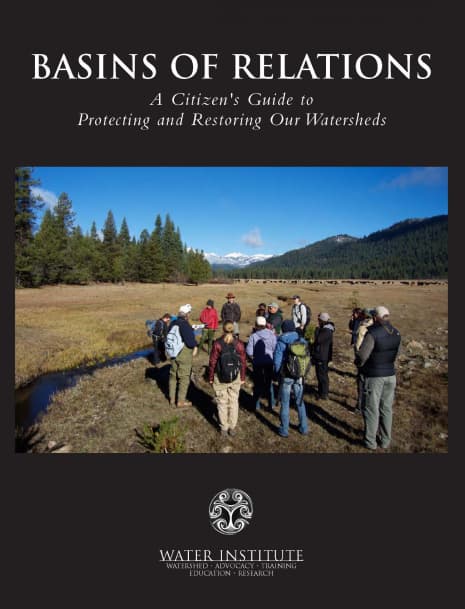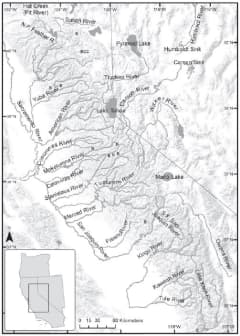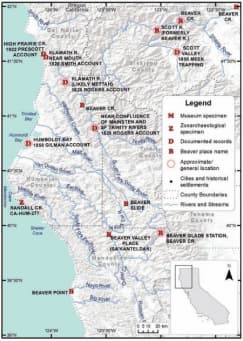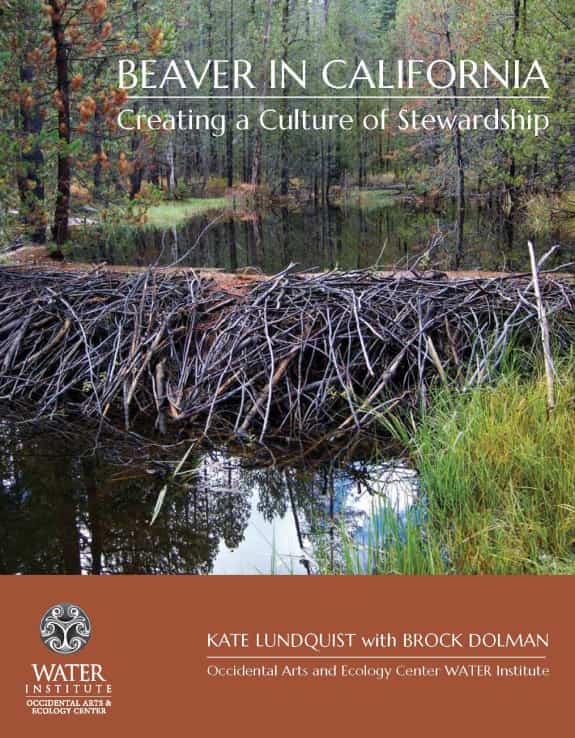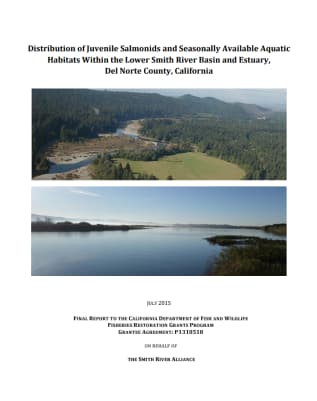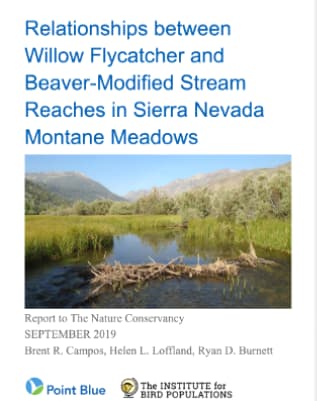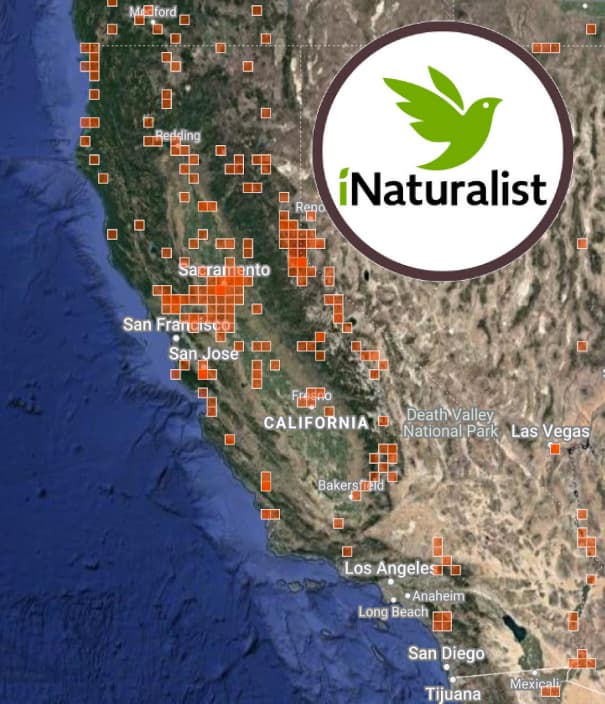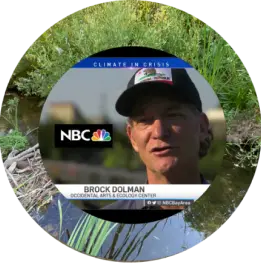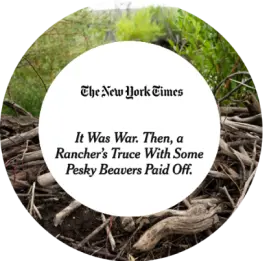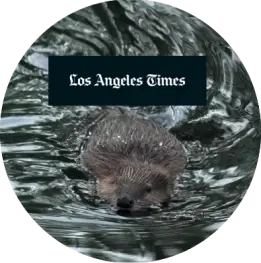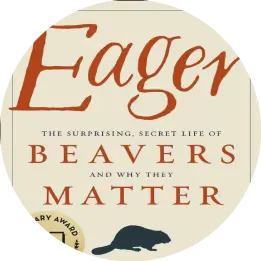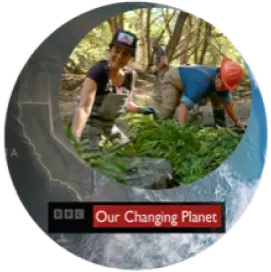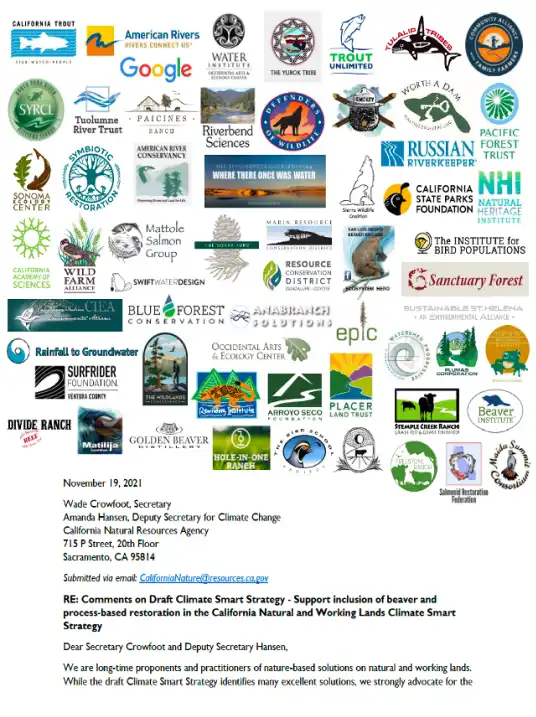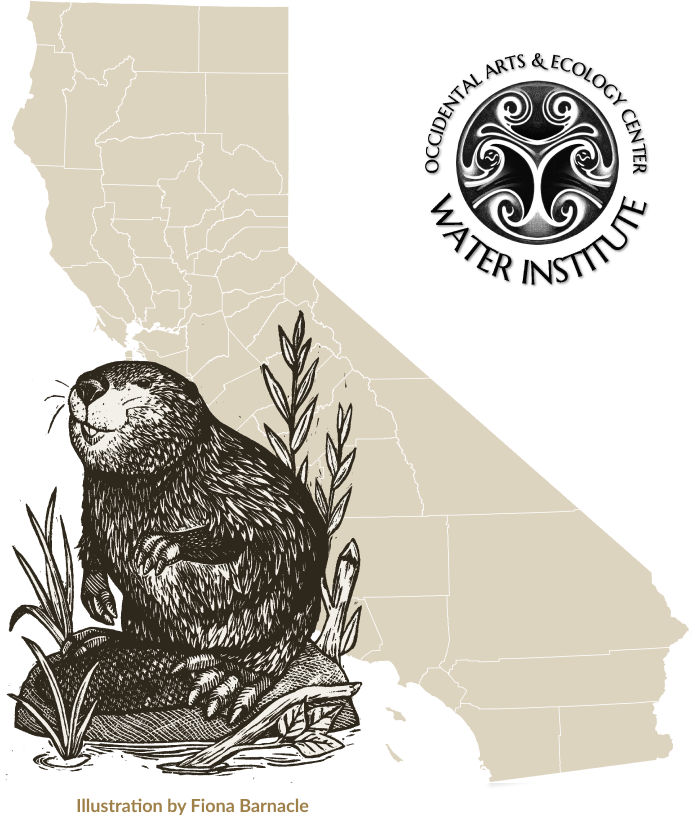
The WATER Institute’s Bring Back the Beaver Campaign is one of California’s leading efforts to legitimize beaver and process-based restoration as low-cost, nature-based strategies to restore our degraded watersheds. With our political eye on the legislature, our trust-building with tribes, our historical research, and our strong media game, we built a campaign and successfully changed the narrative and policy when it comes to beaver restoration in California.
Scroll down to read the story of how we did it…
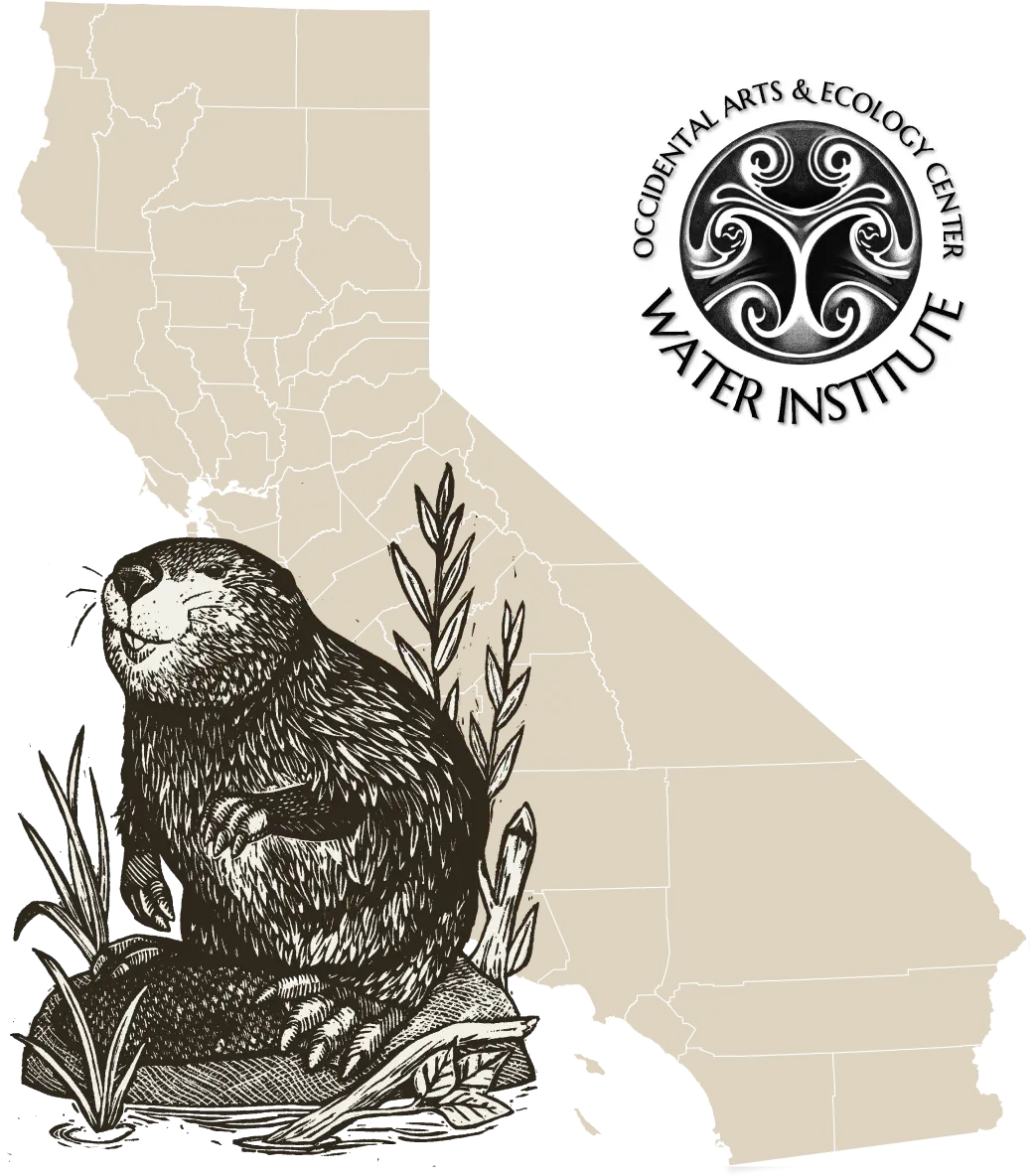
Illustration by Fiona Barnacle
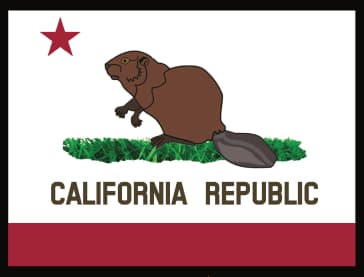
Community Organizing
from Ridgeline to Reef
From 1994 until the official launch of our beaver campaign in 2009, we successfully built communities’ capacities to restore their watersheds through “Basins of Relations” trainings, demonstrations, and policy change work.
At its core, Occidental Arts & Ecology Center is a community-based organizing center. Beyond the interdependence of ecosystems within watershed basins, all of the human relationships or “ego-systems” within those basins are also inextricable. Galvanizing a movement to protect one’s home basin or any one species within that basin needs to involve everyone — from the high mountain meadows to the low valley wetlands to the kelp forests — hence the development of our Ridgeline to River to Reef approach to community organizing.
OAEC’s Strategies for Change
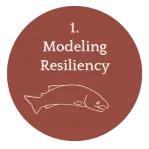
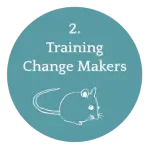
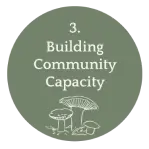
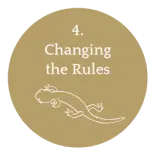
“The first thing we learned from salmon was the importance of the watershed as a unit of perception.”
- Freeman House in Totem Salmon
By 2001, it was estimated that fewer than a dozen coho salmon were left in the Russian River watershed, and we were responding to the urgent need to explore all options to help recover this iconic species.
Given the role they can play in restoring ecological function to riverscapes and critical habitat to coho salmon, we began promoting beaver and process-based restoration across multiple restoration contexts and communities as early as 1999. Through this work, it became clear that there was a need to increase literacy in whole watershed systems thinking. We needed to share the latest scientific findings and best practices and processes for integrating keystone species to accelerate restoration and listed species recovery. In response, the WATER Institute officially launched its Bring Back the Beaver Campaign to increase the recognition and implementation of beaver and process-based restoration as legitimate tools in the conservation toolbox.
footage by Sashwa Burrous
Correcting Historical Misconceptions
While other arid Western states were starting to embrace beaver restoration, we were met with significant resistance in California. This was due in part to beaver being designated (like all rodents) as a “detrimental species” to agriculture and the misperceptions that they were not good for fish and were not native to much of the state. It was clear we needed to change the narrative about beaver being a non-native nuisance, an attitude that greatly contributed to the mismanagement of beaver and easily justified their lethal removal.
2012 & 2013 – Peer-Reviewed Papers Published
We spent several years unearthing the historical evidence, and these four papers, three of which are co-authored by The WATER Institute, prove otherwise: beavers have always been native to much of California and can be incredible agents of habitat restoration and imperiled species recovery.
photo courtesy of Tule River Tribe Beaver Project
A 500- to 1000-year-old beaver pictograph located next to the South Fork Tule River on the Tule River Indian Reservation. (Photo not to be used without permission from the Tule River Tribe.)
Did you know that there are words for beaver in nearly 60 California Native Indigenous languages? Carbon dating and ethnographic research contributed to shifting the widespread and erroneous view that beavers were a non-native invasive species to the fact that they have been a key part of the hydrological cycle and native lifeways in California for thousands of years.
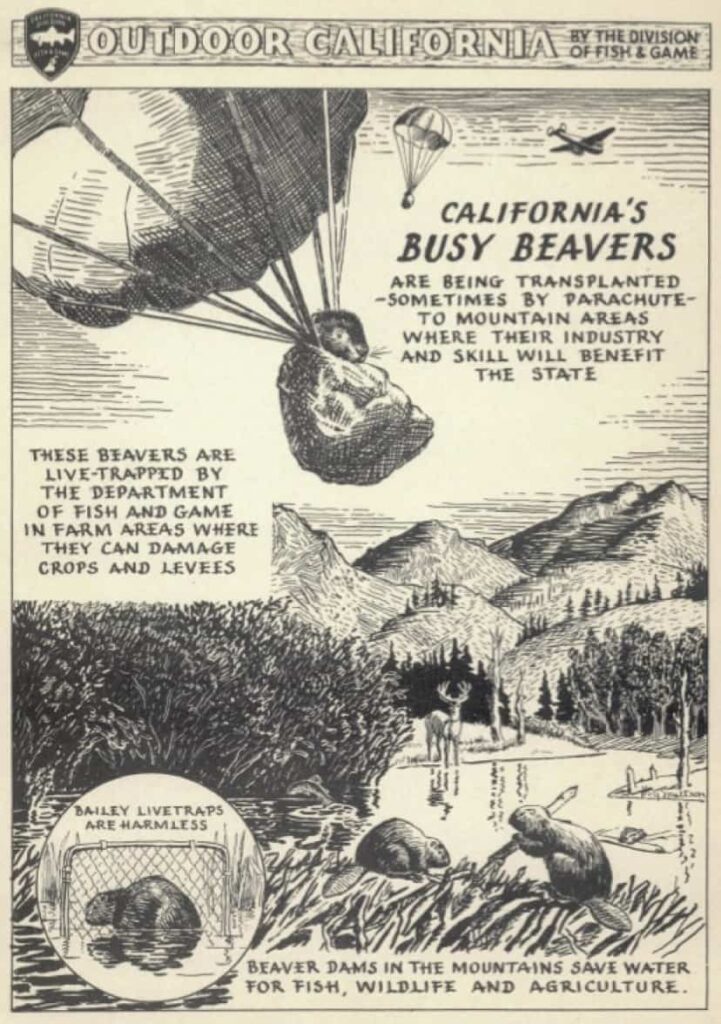
There was a time when California almost lost all of its beaver to trapping and loss of habitat. In the early days of the state, beaver policy went from the decision to fully protect beaver in 1911 to allowing recreational and commercial trapping and the killing of nuisance beaver by 1930.
Our state agency, formerly the Division of Fish and Game, now called the California Department of Fish and Wildlife (CDFW), stepped up to return beaver to their native range and had an active beaver relocation program that ran from 1923 — 1950. As illustrated in this poster, the state recognized and publicized the facts: “Beavers in the mountains save water for fish, wildlife, and agriculture.” This program helped immensely to restore beaver to California, but subsequently added to the public misperceptionthat beaver weren’t native to some of the areas into which they were translocated.
Beaver laws remained mostly unchanged until 2019, when the Wildlife Protection Act outlawed recreational and commercial trapping.
Early Alliance Building
Our campaign began as many OAEC initiatives do — with power mapping and developing short- and long-term strategic plans. We had our eyes on the agencies, the courts, the governors, and other allied groups that could help us leverage important decisions. This helped us identify potentially ripe collaborators and points of change.
We began reaching out, and over the course of many years, gave thousands of personalized talks and tours targeting resource agencies and restoration communities (salmon, meadows, rangelands — from ridgeline to reef), always tailoring the message to address relevant ecological, land use, and community issues associated with the host watershed. We identified groups who were already doing focused restoration on specific habitats and endangered species that could greatly benefit from beaver and process-based restoration and brought the science and examples of successful implementation to their convenings.
In 2012, we convened an ad hoc California Beaver Working Group at the Occidental Arts & Ecology Center (shown here), bringing together researchers, agency staff, tribal partners, advocacy organizations, and beaver champions who helped us identify the obstacles and opportunities we were facing.
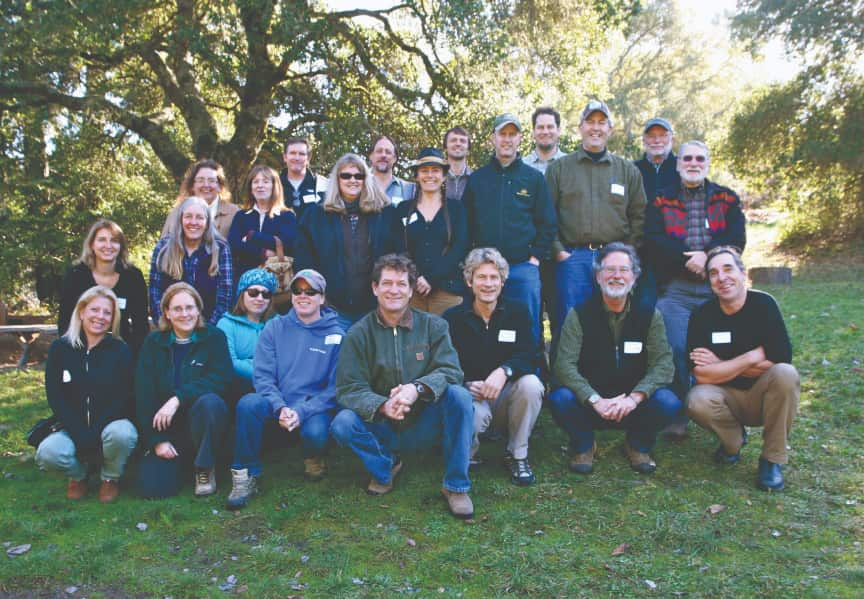
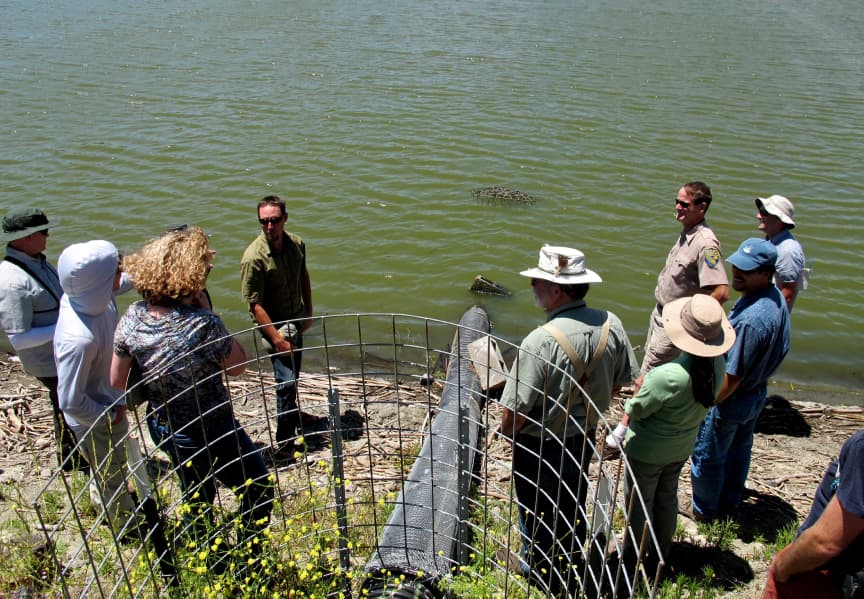
We introduced beaver as key to the recovery of salmon through the Salmonid Restoration Federation (SRF), to the restoration of mountain meadows through the Sierra Meadows Partnership, and to climate change resilience through the California Climate & Agriculture Network (CalCAN) community.
In 2012, SRF gave WATER Institute Co-Director Brock Dolman the “Golden Pipe Award” for beaver innovation. This represented a critical pivot point in turning a previously anti-beaver community into beaver believers.
photo by Brock Dolman
Rather than going the route of lawsuits, we built respected relationships and legitimized beaver restoration science so that we could promote beaver restoration through collaboration. We organized field trips for agency staff to see successful examples of beaver coexistence, and we slowly began changing the hearts and minds of various agency directors and restoration communities.
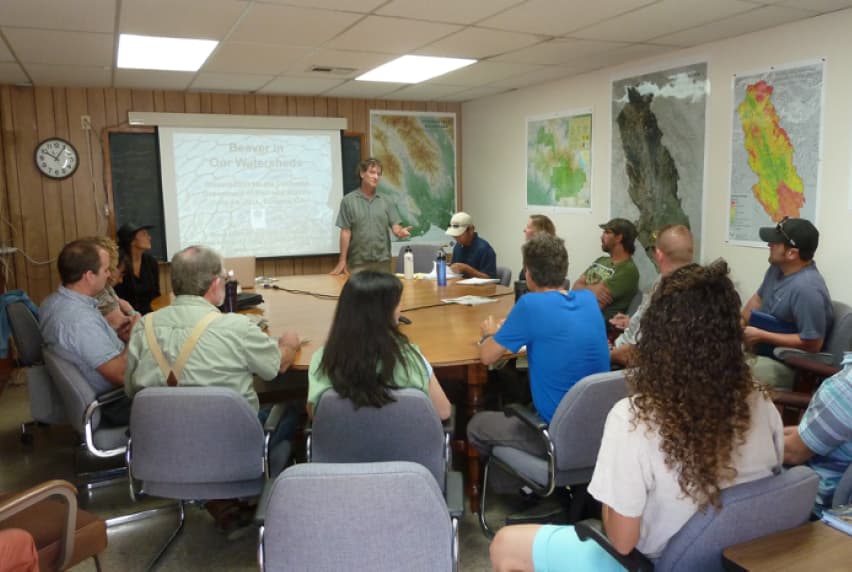
Beaver in California Guidebook
In 2016, the WATER Institute released the first edition of the Beaver in California: Creating a Culture of Stewardship guidebook, a first-of-its-kind resource providing the scientific framework and practical applications of beaver restoration in the state.
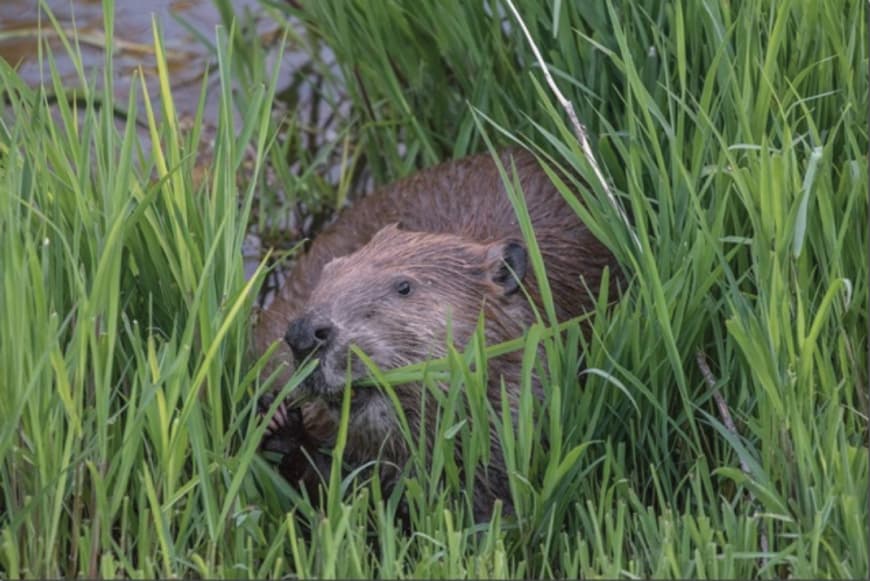
photo by Rusty Cohn
We amplified the voices of ranchers who had become unlikely beaver believers when they saw proof that protecting riparian areas on working lands also protects their bottom line.
“Beaver have done a wonderful thing for this ranch. They slowed the water down, spread it out, and rehydrated the sponge so that water doesn’t disappear. Good fish habitat is good cow habitat too. You can spend gobs of money trying to replicate what beaver do for free.”
- Jon Griggs, Maggie Creek Ranch
photo by Carol Evans, retired Bureau of Land Management officer
Engaging the Scientific Community
We encouraged and supported the scientific community to study and share results about potential benefits of beaver habitats, including both dams and bank lodges, to endangered and threatened species.
In 2015, the WATER Institute co-developed the CASTOR beaver intrinsic potential model with Jacob Pollock to help agencies prioritize locations for possible beaver restoration. Shortly after, from 2017 to 2019, we continued working on similar modeling technology with staff from Utah State University, The Nature Conservancy, and the US Forest Service to run the Beaver Restoration Assessment Tool (BRAT) for California.
photo by Brock Dolman
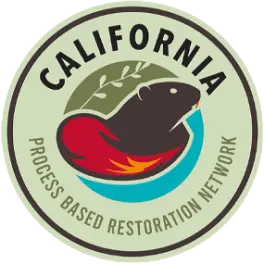
Organizing and Training Restoration Professionals
In 2021, the WATER Institute recognized the need to build professional networks to gather information and share skills. We partnered with several professionals from federal and state resource agencies, California Native American tribes, non-profits, restoration firms, and other interested collaborators to create the California Process Based Restoration Network (calpbr.org).
Partnering with Tribal Communities
At their invitation, we are honored to collaborate with tribal communities in their efforts to bring back the beaver to their ancestral homelands.
Maidu Summit Consortium
In 2018, OAEC was invited to collaborate with other partners to support MSC members in planning and implementing innovative restoration practices on their ancestral lands at Tásmam Koyóm, including developing a beaver recruitment strategy for this culturally important species. In 2023, MSC’s site Tásmam Koyóm was selected as the recipient of the first CDFW beaver translocation in nearly 75 years.
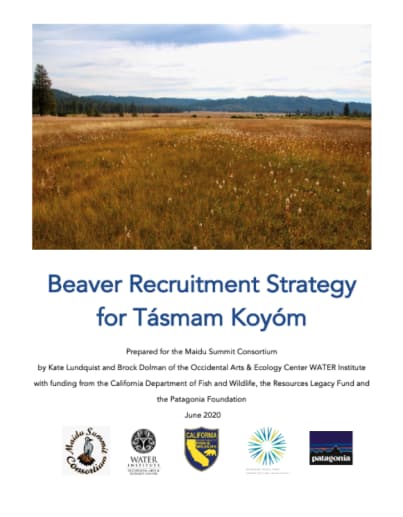
Tule River Tribe
In 2015, Tule River Tribe Range Supervisor Kenneth McDarment asked for help to return beaver to Tule River tribal land. In 2020, we began working with the tribe and other partners to assess beaver habitat and implement process-based restoration strategies to restore upland meadows, creeks, and the main stem South Fork Tule River. The California Department of Fish & Wildlife selected the Tule River Tribe in 2023 for one of their two pilot translocation projects, which was successfully carried out in the summer of 2024!

photo by California Department of Fish and Wildlife
Outreach to Targeted Audiences and Beyond
We delivered the evidence-based facts to every audience possible, often with catchy quips, puns, and memes to help make the information more accessible. By connecting the science of beaver benefits to pressing issues and highlighting the endangered species that benefit from beaver and process-based restoration, we were able to leverage the media to rally behind our adorable climate change-mitigating mascot.
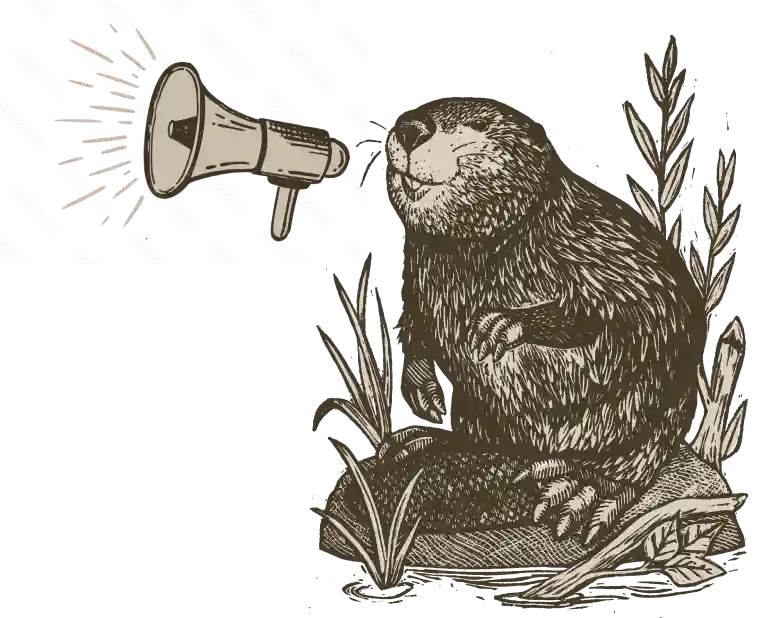
illustration by Fiona Barnacle
Building Coalitions,
Building Momentum
The WATER Institute’s advocacy efforts got a significant boost in 2021, when we began working with lobbyist Jennifer Fearing of Fearless Advocacy, Inc. She accelerated the beaver policy overhaul and state funding process we were guiding, including helping to coordinate a massive show of support for a letter we submitted to Director Wade Crowfoot at the California Natural Resources Agency. Beaver and process-based restoration are now included as nature-based solutions in the final version of the Natural and Working Lands Climate Smart Strategy.
photo by Kate Lundquist
“To be successful in our efforts to protect biodiversity, the Department must take a proactive leap towards bringing beavers back onto the landscape through a concerted effort to combine prioritized restoration projects, partnerships with local, federal, and state agencies and tribes, and updated policies and practices that support beaver management and conservation throughout the State… beavers are an untapped, creative climate solving hero that helps prevent the loss of biodiversity facing California.”
- California Governor Gavin Newsom
photo by Rusty Cohn
Changing the Rules
In 2019, the WATER Institute, the Environmental Information Protection Center, and the Center for Biological Diversity filed a regulation change petition with the California Fish and Game Commission. The request centered on getting CDFW to develop a rigorous guidance document for how they issue beaver depredation permits (permission to kill a beaver that has caused property damage). The petition advocated that landowners be required to try coexistence measures first and, if present, protect endangered species before receiving a permit to kill beaver.
Our requests were integrated into a new beaver depredation guidance document released by CDFW in 2023. CDFW redesigned its beaver webpage, formally acknowledging their conservation value and including links to the WATER Institute’s publication Beaver in California: Creating a Culture of Stewardship.
“Brock, I want to thank you for your leadership on this. I remember our first conversation about eight years ago when I first got on the commission. It’s folks like you who have passion and are tireless and resilient on these issues that make things like this happen. So thank you for your efforts.”
—Eric Sklar, President of the
California Fish and Game Commission
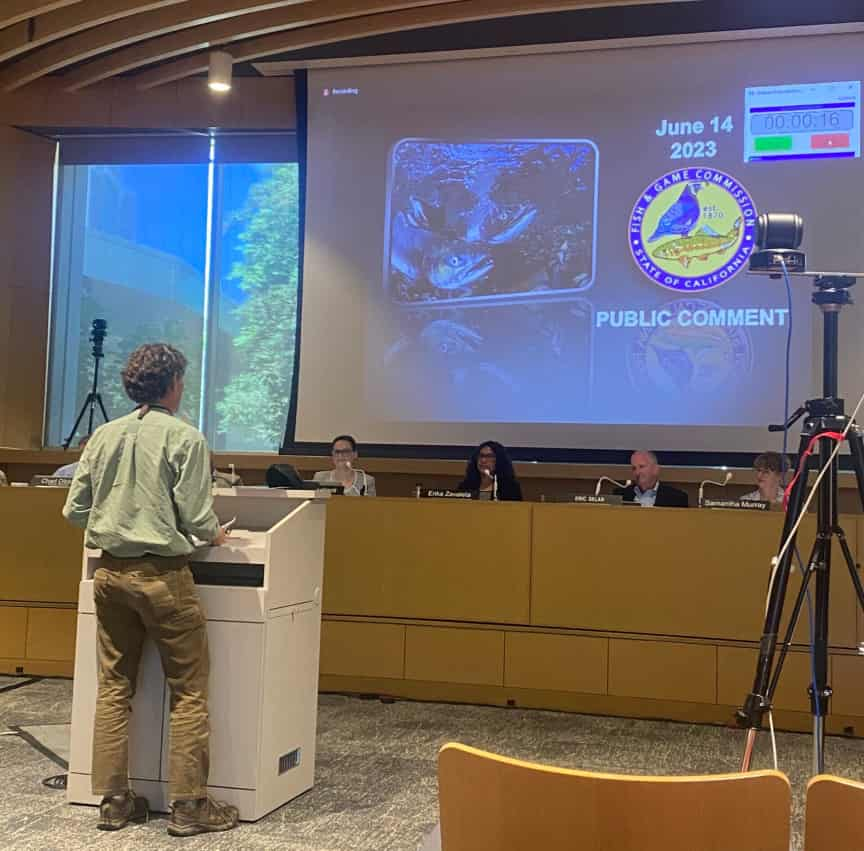
Brock Dolman presenting at the California Fish & Game Commission meeting when the new guidelines for depredation were adopted.
In 2023, the first beaver translocation in nearly 75 years was carried out by the CDFW Beaver Restoration Program at Tásmam Koyóm!
CDFW Beaver Restoration Program
and Grant for Coexistence
We have now entered into the next phase of implementation, leading the effort to help carry out many of these hard-earned changes.
In 2022, the California legislature approved the Governor’s budget, including funds to create a new CDFW-led Beaver Restoration Program. The program includes
- Developing a coexistence toolkit for human–wildlife conflict
- Piloting beaver conservation and translocation projects
- Convening a Technical Advisory Group that will include OAEC staff
In March 2024, the Occidental Arts & Ecology Center was awarded $2 million to design and launch the first-of-its-kind California Beaver Coexistence Training and Support Program. This program will provide financial and technical support through a California Beaver Help Desk to assist landowners and land managers seeking to implement beaver coexistence.
photo by Brock Dolman
“I’ll be honest, we’re here because of the efforts of you [OAEC] and so many others who saw the potential, saw the mistakes we made in history, advocated, and held us accountable at the state and federal level to change policy to expand beaver habitat.”
– Wade Crowfoot, California Natural Resources Agency Secretary
View a detailed timeline of OAEC’s Bring Back the Beaver Campaign.
photo by Rusty Cohn
Lorem ipsum dolor sit amet
Lorem ipsum dolor sit amet, consectetur adipiscing elit, sed do eiusmod tempor incididunt ut labore et dolore magna aliqua. Ut enim ad minim veniam, quis nostrud exercitation ullamco laboris nisi ut aliquip ex ea commodo consequat. Duis aute irure dolor in reprehenderit in voluptate velit esse cillum dolore eu fugiat nulla pariatur. Excepteur sint occaecat cupidatat non proident, sunt in culpa qui officia deserunt mollit anim id est laborum.
Lorem ipsum dolor
Lorem ipsum dolor sit amet, consectetur adipiscing elit, sed do eiusmod tempor incididunt ut labore et dolore magna aliqua. Ut enim ad minim veniam, quis nostrud exercitation ullamco laboris nisi ut aliquip ex ea commodo consequat. Duis aute irure dolor in reprehenderit in voluptate velit esse cillum dolore eu fugiat nulla pariatur. Excepteur sint occaecat cupidatat non proident, sunt in culpa qui officia deserunt mollit anim id est laborum.Lorem ipsum dolor sit amet, consectetur adipiscing elit, sed do eiusmod tempor incididunt ut labore et dolore magna aliqua. Ut enim ad minim veniam, quis nostrud exercitation ullamco laboris nisi ut aliquip ex ea commodo consequat. Duis aute irure dolor in reprehenderit in voluptate velit esse cillum dolore eu fugiat nulla pariatur. Excepteur sint occaecat cupidatat non proident, sunt in culpa qui officia deserunt mollit anim id est laborum.
Lorem ipsum dolor sit amet, consectetur adipiscing elit, sed do eiusmod tempor incididunt ut labore et dolore magna aliqua. Ut enim ad minim veniam, quis nostrud exercitation ullamco laboris nisi ut aliquip ex ea commodo consequat. Duis aute irure dolor in reprehenderit in voluptate velit esse cillum dolore eu fugiat nulla pariatur. Excepteur sint occaecat cupidatat non proident, sunt in culpa qui officia deserunt mollit anim id est laborum.
Lorem ipsum dolor sit amet
Lorem ipsum dolor sit amet, consectetur adipiscing elit, sed do eiusmod tempor incididunt ut labore et dolore magna aliqua. Ut enim ad minim veniam, quis nostrud exercitation ullamco laboris nisi ut aliquip ex ea commodo consequat. Duis aute irure dolor in reprehenderit in voluptate velit esse cillum dolore eu fugiat nulla pariatur. Excepteur sint occaecat cupidatat non proident, sunt in culpa qui officia deserunt mollit anim id est laborum.Lorem ipsum dolor sit amet, consectetur adipiscing elit, sed do eiusmod tempor incididunt ut labore et dolore magna aliqua. Ut enim ad minim veniam, quis nostrud exercitation ullamco laboris nisi ut aliquip ex ea commodo consequat. Duis aute irure dolor in reprehenderit in voluptate velit esse cillum dolore eu fugiat nulla pariatur. Excepteur sint occaecat cupidatat non proident, sunt in culpa qui officia deserunt mollit anim id est laborum.
